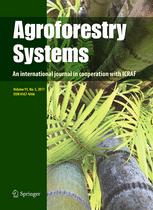View Item
- xmlui.general.dspace_homeCentros Regionales y EEAsCentro Regional Patagonia SurEEA Santa CruzArtículos científicosxmlui.ArtifactBrowser.ItemViewer.trail
- DSpace Home
- Centros Regionales y EEAs
- Centro Regional Patagonia Sur
- EEA Santa Cruz
- Artículos científicos
- View Item
Soil microbial processes in a pine silvopastoral system in NW Patagonia
Abstract
The conversion of native vegetation to tree plantation (afforestation) implies a drastic change in life forms and as a consequence, changes in the microenvironmental conditions, and the quantity and quality of organic matter entering the soil.This could affect soil microbial communities and the processes catalyzed by them. In Patagonia, afforestation with exotic, fast-growing tree species was a common practice but the consequences on the ecosystem remain
[ver mas...]
The conversion of native vegetation to tree plantation (afforestation) implies a drastic change in life forms and as a consequence, changes in the microenvironmental conditions, and the quantity and quality of organic matter entering the soil.This could affect soil microbial communities and the processes catalyzed by them. In Patagonia, afforestation with exotic, fast-growing tree species was a common practice but the consequences on the ecosystem remain poorly quantified. The objective was to study the effects of pine afforestation on litter decomposition, soil organic matter, soil microbial activity and associated biogeochemical functions in a semiarid area of NW Patagonia. We hypothesized
that afforestation would decrease litter decomposition rate and soil biological activity including net N mineralization, due to changes of environmental
conditions and organic matter quality. We measured in situ and potential soil net N mineralization, soil microbial biomass-C, soil enzyme activities (β-glucosidase, acid phosphatase and leucin-aminopeptidase) and litter decomposition rate. We also characterized soil pH, electrical conductivity, extractable P and total C and N. Pine plantations clearly affected decomposition rates of native grass
vegetation, which was 10% lower under pine canopy cover, and decreased soil microbial biomass. Acid phosphatase activity and leucin-aminopeptidase
activities were also marginally reduced. On the other hand, we did not find any significant effects of pines on soil chemical properties and N transformations
after 13 years of plantation. Because effects depend strongly on time, the decrease of soil microbial biomass, acid phosphatase activity and grass decomposition rate (and the trend to lower enzyme activities related to P and N) under pine cover could be an evidence of possible changes on the long-term.
[Cerrar]

Fuente
Agroforestry systems 93 (1) : 255–266 (February 2019)
Date
2018-02
ISSN
0167-4366 (Print)
1572-9680 (Online)
1572-9680 (Online)
Formato
pdf
Tipo de documento
artículo
Palabras Claves
Derechos de acceso
Restringido
 Excepto donde se diga explicitamente, este item se publica bajo la siguiente descripción: Creative Commons Attribution-NonCommercial-ShareAlike 2.5 Unported (CC BY-NC-SA 2.5)
Excepto donde se diga explicitamente, este item se publica bajo la siguiente descripción: Creative Commons Attribution-NonCommercial-ShareAlike 2.5 Unported (CC BY-NC-SA 2.5)

